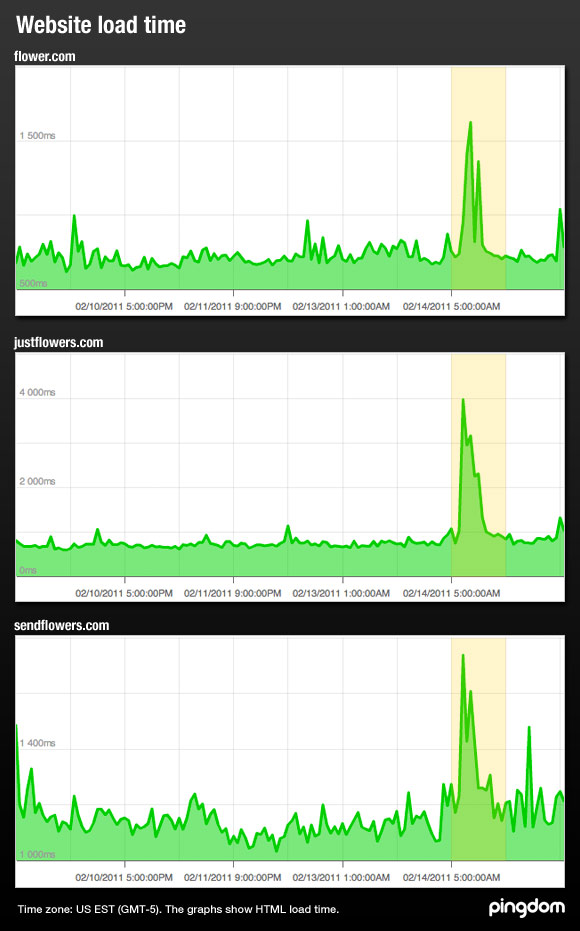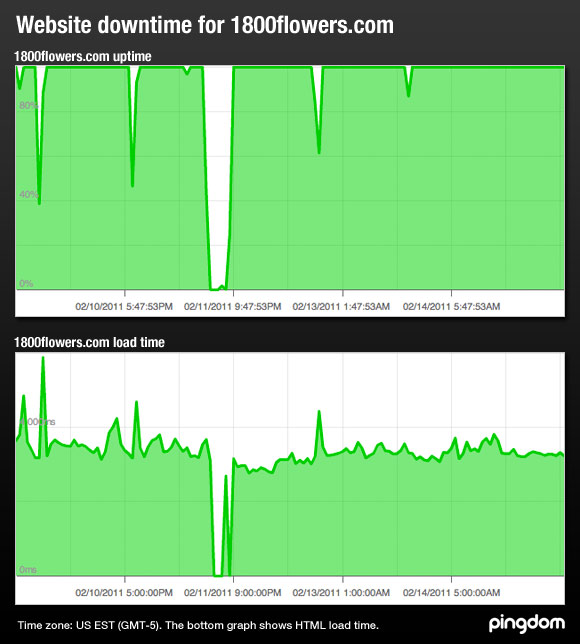 Valentine’s Day is a great day for any vendor selling flowers. Over the years, a large number of websites selling flowers have sprung up, and as you might expect, many of these websites are flooded by eager shoppers on February 14 wanting to buy flowers and gifts for their loved ones.
Valentine’s Day is a great day for any vendor selling flowers. Over the years, a large number of websites selling flowers have sprung up, and as you might expect, many of these websites are flooded by eager shoppers on February 14 wanting to buy flowers and gifts for their loved ones.
This is big business. Americans are expected to spend $18.6 billion on Valentine’s Day gifts this year.
Now here is the catch. Every year, some of these websites won’t be prepared to handle the increase in visitor traffic and as a result they slow down significantly, or even crash under the pressure.
Downtime and slowdown is extra bad for ecommerce sites
Webmasters failing to take expected (or unexpected) traffic spikes into account are all too common. For an ecommerce website, this is of course a very critical error. Just compare it with a regular real-life flower shop:
- A slow website will turn away customers because it’s the equivalent of poor, slow service. That clerk seems to be ignoring you, or the line to the counter is moving in slow motion.
- A crashed website is not only embarrassing, but is the same as completely closing shop with a big sign saying: “Go to some other shop and spend your money, we’re closed!”
Neither of the two is something a flower website would want to do on Valentine’s Day, one of the busiest days of the year, perhaps the busiest.
We here at Pingdom run an uptime monitoring service, so this year we decided to see how some of the more popular flower websites would handle themselves on, and in the days leading up to, Valentine’s Day. Would they hold up? Would they slow down a lot?
Slowdown and crashes
Several websites showed clear slowdown, especially in the morning hours of Valentine’s Day. A lot of last-minute orders in other words. Here are some very telling charts for three of the websites we monitored, Flower.com, Justflowers.com and Sendflowers.com.

We chose these three sites because they so clearly illustrate the increased load these sites are subjected to, and that it can actually noticeably affect the performance of a website. And note that this is just the load time of the HTML code of the website, without images. The overall load time was in other words even slower.
Out of the websites we monitored for this survey, one clearly stood out for two reasons. One was that it was generally much slower than the others, and second because it recorded a significant amount of downtime. More than eight hours in just the past few days, most of it on Friday afternoon, US time, when it was unavailable for four hours and then even more later in the evening.
That site was 1800flowers.com.

Another site that also had downtime at a very bad time, almost and hour-and-a-half spread over the day on February 14, was 1stinflowers.com. The site also showed a similar increase in load time as you could see in the examples we included above.
Now, we’ve mentioned mainly sites where something went either wrong, or hinted at some kind of performance issue or degradation due to the increase in traffic. But, there were sites that worked just fine, with no noticeable issues. These include Proflowers.com, Shop.marthastewart.com, Hallmark.com and Findaflorist.com.
Conclusion
Downtime and slowdown can and will happen to all websites. However, sometimes the timing can be very bad, and a flower website having problems during business hours on Valentine’s Day, or even the days leading up to Valentine’s Day, is a prime example of bad timing.
In most cases this could likely have been avoided if the websites had been better prepared to handle the additional traffic. Instead, some of these sites have ended up losing sales and goodwill (slow websites tend to be quite a frustrating experience).
By the way, if you are interested in digging into the data yourself, or keep an eye open over time, we’ve set up a public, continuously updated report page: U.S. Flower Websites, uptime and response time status page. There you can find all the sites included in this survey, including some we didn’t mention.


























